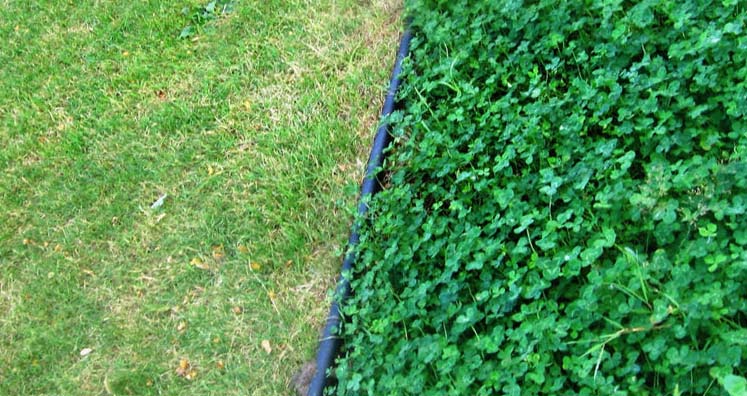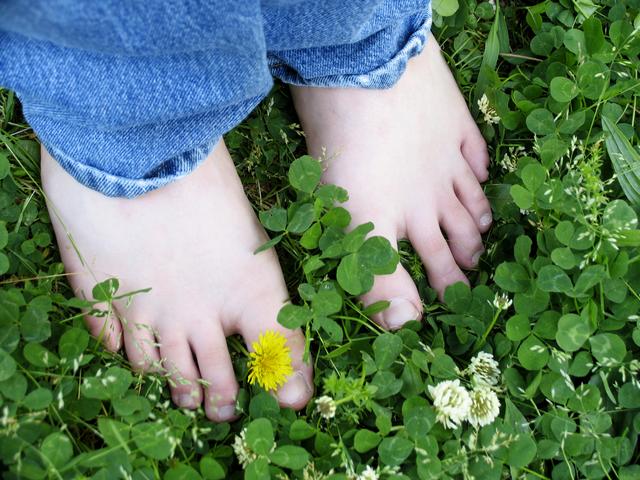Rumble Pie #11
Clover and Out
TWO DAYS AGO, I promised you a blog about clover lawns as an alternative to grass. Then I took you time-travelling into history to understand the back-story. In Part I, Clover the Hills and Far Away, and Part II, Clover and Over Again, I explained how the artistic imagination of the Middle Ages triggered a new paradigm for gardening during the Renaissance. You've got to know where you're coming from, if you want to figure out where you're going, right? So now in Part III, Clover and Out, I will talk about how this new paradigm has perverted our senses of space and society, our relationships with nature and culture, and left us with a chemical legacy of lifeless monoculture. And finally, I won't only talk about the problem, but I'll suggest some possible solutions. So, one more time, what's wrong with our good friend green grass, and why would we want to examine any alternatives?
GRASSY LAWNS HAD come to be associated with upper-class status in the minds of the rest of us peasants. And so some of the first important public parks on this continent, Central Park in Manhattan and Prospect Park in Brooklyn, were designed with the English pastoralist style in mind. But until the Second Industrial Revolution about a hundred and fifty years ago, most of the North American Continent was covered with moss and shrub. The average person couldn't possibly afford a retinue of caretakers to constantly monitor the length of the lawn and incessantly scythe it down to mere centimetres. It wasn't until the rise of the machines that manicured lawns were within the reach of the commoners. With the arrival of the lawn mower by the mid-1800s and the first fossil-fuel-powered mower emerging at the turn of the twentieth century, average Joes and Janes could adopt the tropes of the ridiculously prosperous and simulate at least the appearance of affluence.


TODAY, EXACTLY HALF of the world's population lives in urban areas; here in Canada, that rate is as high as four-fifths, and in Ontario it's even more than that. A mock meadow has no meaning in a metropolitan Toronto: you can't take your flock of sheep out to graze on the grass; you can't possibly take a long, romantic walk in the woods; and you certainly can't get lost in the forest, enchanted by the wondrousness of it all. You are bound in by fences and borders, enclosed on all sides with stick pickets and chain links. At most, you can take the domesticated dog outside so he doesn't defecate on your carpet. You can make a fake firepit and burn a meaty meal on open coals, brought in by rail from a coal mine on the east coast of the country. You can nuke the lawn till it's more florescent than anything else that grows on the Goddess' green earth, but I'm sorry to say it, your little slice of heaven remains short of satisfying.
ASSUMING THAT YOU CAN'T see yourself anthropomorphizing blades of grass and that it doesn't trouble you at all to continually castrate the sex of these small green creatures (which is how the grass experiences lawn mowing), and that you've got lots of disposable income so you don't mind paying labourers to mow the lawn often -- there's still the matter of chemical maintainance. When they're in the wild, grasses don't keep green from May to September, they're only emerald for a few weeks at a time, after which they fade to a pale pastel. Exactly a century ago, the first artificial fertilizers were invented to mess with the chemistry of the grass and trick it into staying jade green all season long. Then military-industrial R & D gave us the means to more efficiently kill off all the other species on the lawn without the exhausting, almost impossible task of weeding: herbicides and insecticides. So now we wage carcinogenic chemical warfare on the earth itself. And for what? To keep up with the Windsors?


THERE ARE ALL KINDS of alternatives that would be preferable to the grassy status quo, things you can let your lawn do. But the first proposal I can come up with off the top of my head is clover. Until the 1950's, clover was considered to be a desirable item. But when the chemical corporations realized that their marketable products killed off clover as well as the other weeds, they re-branded clover as evil. How fickle and foolish we were to have bought their propaganda! Clover remains incandescent green as long as it's pleasant to be outside, and can't be discoloured, even by canine urine. It flourishes in sub-standard soil, fixing nitrogen into it, actually improving soil quality. It wages a war on weeds for you, crowding them out by natural selection. It demands so very little from you, only a small amount of water, much less than grass. And it certainly doesn't need to be mowed -- it automatically grows to a height of about twenty centimetres, and stays there perpetually.
THE ONLY THING you could possibly say against clover is that bees love it. And some people -- especially little people -- don't necessarily love bees back. That humans have almost eradicated the natural habitats of bees, threatening them with extinction, and jeopardizing our own survival on this planet at the same time, since bees pollenate one-third of all human food -- is a topic for another blog entry. But for now, let's just settle the clover question by arming ourselves with the knowledge that maintaining a whole host of different types of flora in your yard will ensure a diversity of species -- including insects -- naturally keeping the bees in check. And if you're planning on using it in a high-traffic area, then you want to mix it up with other ground-cover anyway. The idiom "to be in clover" even means to live the good life, carefree and easy -- that's no linguistic accident!


To learn more about the history of how we surround our houses with lifeless lawns, I highly encourage you to read the excellent article entitled Turf War, written by Elizabeth Kolbert, published exactly a year ago in The New Yorker magazine.
|

